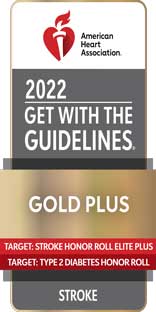
When a stroke occurs, immediate medical care is essential. Every minute counts; getting treatment as quickly as possible could be the difference between life and death.
Know the signs and symptoms of stroke.
- Sudden numbness or weakness in the face, arm or leg; numbness is often localized to just one side of the body.
- A sudden sense of confusion is common in stroke victims. The victim may have difficulty speaking or understanding what is being said.
- Sudden difficulty seeing (with one or both eyes).
- Sudden severe headache with no clear cause.
- Sudden trouble walking, which may include dizziness, loss of balance, or lack of coordination.
Types and Causes of Stroke
Ischemic Stroke
An ischemic stroke occurs when a blood vessel of the brain becomes blocked. Nearly 90 percent of all strokes are ischemic. Blockage may be caused by:
- Carotid artery stenosis. Narrowing of the carotid arteries that supply blood to the brain. The narrowing occurs as a result of atherosclerosis, the buildup of plaque (fat, cholesterol, and other substances) inside artery walls.
- Thrombus. A blood clot that forms in the arteries of the brain, often a result of atherosclerosis.
- Embolism. A blood clot that travels from another part of the body. In many cases, the clot travels from the heart and gets trapped in the arteries that supply blood to the brain. A common cause of embolism is atrial fibrillation, a type of heart arrhythmia.
- Arterial spasm. Blood vessels have muscular walls that can tighten or loosen to help blood flow. Problems with nerves, blood vessel structure, injuries, or stimulants can cause these muscles to spasm and tighten, making it difficult for blood to flow through the blood vessel. Although spasms can cause problems on their own, they may be more likely to cause blockages in blood vessels with current atherosclerosis.
Hemorrhagic Stroke
A stroke may also occur if a blood vessel breaks and bleeds into or around the brain. Hemorrhagic stroke is the most common type of stroke in young people. The leading causes of this type of stroke are:
- Hypertension. Blood pressure is the force of blood on arteries walls. Prolonged high blood pressure damages and weakens blood vessels.
- Brain aneurysm. An aneurysm is an outpouching of a blood vessel wall in the brain that form in areas where the artery wall is weak or thin. The bulging, blood-filled pocket can put pressure on parts of the brain. Aneurysms that burst often have devastating consequences.
- Ateriovenous malformations (AVM). A rare condition marked by abnormal connections that occur between arteries and veins. Instead of an artery supplying an area of the brain with blood, it is connected directly to a vein that takes it away, bypassing the brain tissue that needs it. The blood vessels may be weakened over time. This, in turn, may cause widening of the vessels, which may eventually burst.
Silent Stroke
A silent stroke occurs without any typical signs or symptoms of a stroke. Despite this, silent strokes cause damage to brain tissue and increase the risk of a major stroke in the future. Silent strokes tend to occur in silent areas of the brain that are not obviously active in cognitive function or mobility. Brain tissue damage is usually found incidentally during imaging tests.
If you suspect someone is having a stroke, it is critical to act fast. There is a three-hour window following the first symptoms during which stroke victims may be eligible for the most effective treatments. After that three-hour window, the patient may not be eligible for those first-line therapies.
Act FAST
Act F.A.S.T. if you think someone is having a stroke:
- F–Face: Ask the person to smile. Does one side of the face droop?
- A–Arms: Ask the person to raise both arms. Does one arm drift downward?
- S–Speech: Ask the person to repeat a simple phrase. Is their speech slurred or strange?
- T–Time: If you notice any of these three signs, call 9-1-1 immediately.
In the event of a stroke, call an ambulance so that first responders can begin potentially lifesaving treatment on the way to Glenwood Regional Medical Center. Do not attempt to drive yourself or a stroke victim to the hospital.
Are You at Risk?
Some stroke risk factors can’t be changed. These include age, family history, race, sex, and medical history.
- Age: Risk for stroke doubles for each decade after age 55.
- Family History: You may be at increased risk if you have a parent, grandparent, or sibling who has had a stroke.
- Race: African-Americans are at a higher risk for death from stroke (compared to Caucasians), party due to higher risks of diabetes, hypertension and obesity.
- Sex: Women have more strokes than men. Use of oral contraceptives and other hormonal therapies may increase a woman’s risk.
- Medical History: if you have had a heart attack, stroke or “warning stroke” before, then you are at an increased risk.
Other risk factors may be managed. These include:
- Atrial fibrillation
- Carotid artery disease (or other forms of plaque buildup in arterial walls)
- Cigarette smoking
- Diabetes mellitus (all types)
- Heart disease
- High blood cholesterol
- High blood pressure
- Obesity and/or physical inactivity
- Peripheral artery disease (PAD)
- Poor diet
- Sickle cell anemia
At Glenwood Regional Medical Center, we care about out patients. That's why we've made a commitment to turn treatment guidelines into lifelines. To learn more, visit www.heart.org/quality.
Are You At Risk for Stroke?
According to the Centers for Disease Control and Prevention (CDC), stroke is a leading cause of death and serious long-term disability — with someone in the U.S. suffering a stroke every 40 seconds. To determine if you are at risk for stroke, please answer the following questions.
- Do you or an immediate family member ever have a stroke?
- Have you ever had a heart attack or experienced angina?
- Do you have diabetes?
- Have you ever been diagnosed with high blood pressure?
- Have you ever been diagnosed with high cholesterol?
- Do you smoke?
- Do you exercise regularly (minimum 30 minutes, three times a week)?
- Are you more than 14 lbs. overweight?
- Do you consume alcohol on a daily basis?
- Are you 50 years of age or older?
If you answered “yes” to three or more of the above questions, please contact your personal medical provider. This questionnaire has been created for educational purposes only and should not be used as a substitute for professional medical advice, diagnosis, treatment or care. Only a physician or other qualified health care provider can accurately diagnose and treat stroke.
Call 911 immediately if you or someone nearby is experiencing the warning signs of stroke.


